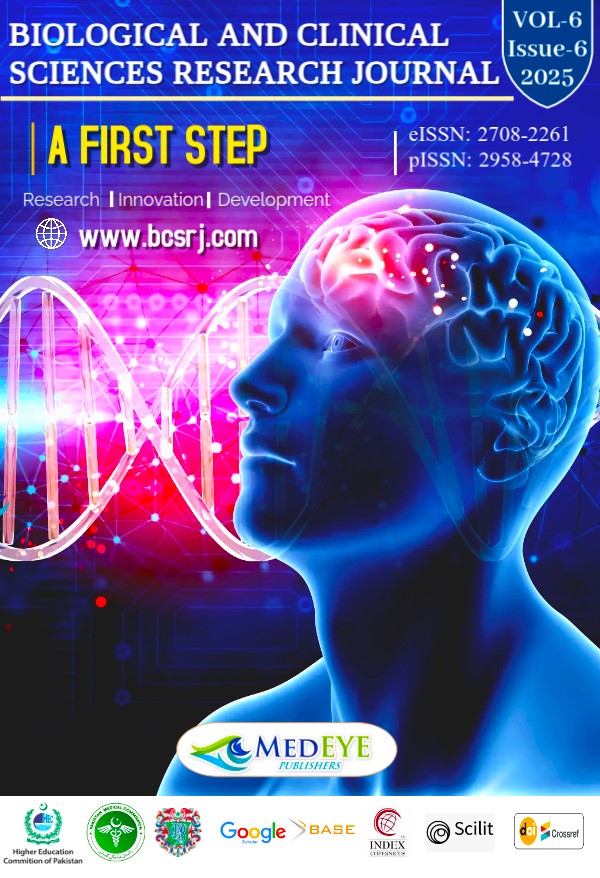Frequency of Bednar's Aphthae in Neonates in a Tertiary Care Hospital in Karachi, Pakistan
DOI:
https://doi.org/10.54112/bcsrj.v6i6.1870Keywords:
Bednar's aphthae, neonates, bottle feeding, oral ulcer, feeding trauma, PatientsAbstract
Bednar's aphthae are benign ulcerative lesions typically observed on the hard palate of neonates, often resulting from mechanical trauma during feeding. Despite being self-limiting, they are underdiagnosed and underreported, particularly in developing countries like Pakistan. Objective: This study aimed to determine the frequency of Bednar's aphthae and explore associated risk factors among neonates in a tertiary care setting in Karachi. Methods: A cross-sectional study was conducted at the Pediatric Medicine OPD of Liaquat National Hospital, Karachi, from June 2024 to December 2024. A total of 105 neonates aged less than one month were enrolled. Data on demographics, feeding method, delivery mode, and socioeconomic status were collected through a structured Performa. Results: The frequency of Bednar's aphthae was found to be 13.3% (14 out of 105 neonates). A significant association was observed between feeding method and presence of aphthae (p = 0.001), with 71.4% of cases occurring in bottle-fed infants. No statistically significant relationship was found with gender (p = 0.73), age group (p = 0.18), mode of delivery (p = 0.12), or socioeconomic status (p = 0.09). Conclusion: Bednar's aphthae are not uncommon and are significantly associated with bottle feeding. Educating caregivers about proper feeding techniques and promoting breastfeeding could help prevent this condition. Early recognition can prevent misdiagnosis and unnecessary treatment. Further studies are warranted to explore broader risk factors and preventive strategies.
Downloads
References
M. C. Plewa and K. Chatterjee, Aphthous Stomatitis, StatPearls Publishing, Treasure Island, FL, USA, 2019, http://europepmc.org/books/NBK431059
Nam SW, Ahn SH, Shin SM, Jeong G. Clinical features of Bednar's aphthae in infants. Korean J Pediat. 2016;59(1):30-4. http://doi.org/10.3345/kjp.2016.59.1.30
Theiler M, Schwieger-Briel A, Cont M, Relly C, Sauteur PM. Bilateral palatine ulcers in a neonate: Bednar's aphthae. Arch Dis Childhood. 2017:103(11);1020-5 http://doi.org/10.1136/archdischild-2017-314045
Bohn H. Die mundkrankheiten der kinder. Engelmann; 1866.
Brecelj A: Über einen pseudodiphtherischen Symptomkomplex bei Neugeborenen. Jahrb Kinderheilkd 1904;59:54–73.
Epstein A: Über septische Erkrankungen der Schleimhäute bei Kindern. Arch Kinder heilkd 1880;1:25–45
Epstein A. Uber pseudodiphtheritis septhamischen ursprungs bei Neugeborenen und Sauglingen. Jahrb Kinderheilkld. 1895;39:420-40.
Linzenmeier G. Sepsis bei Neugeborenen, ausgehend von den Bednar’schen Aphthen. Zentralbl Gynakol. 1911;50:35-7.
von Berlin-Heimendahl S. Die Krankheiten des Neugeborenen und Frühgeborenen: ihre Erkennung und Behandlung in der Praxis. Enke; 1960
Ewerbeck H: Der Säugling. Heidelberg, Springer, 1962.
Taeusch HW, Ballard RA, Gleason CA: Av-ery's Diseases of the Newborn, ed 8. Philadelphia, Elsevier, 2005.
Roth B: Schleimhautläsionen bei Neugeborenen. Monatsschr Kinderheilkd 2001;149:1-5.
Nebgen S, Kasper HU, Schäfer D, Christ H, Roth B. Bednar’s aphthae in neonates: incidence and associated factors. Neonatol. 2010;98(2):208-11. http://doi.org/10.1159/000285523
Narukama R, Takahashi K, Arimitsu T, Hara-Isono K, Shimizu H, Ikeda K. Incidence and clinical risk factors of Bednar's aphthae in Japanese newborns. Pediatr Intl. 2023;65(1): e15 http://doi.org/10.1111/ped.15631
Madurapperuma, Sandara W., Andra H. Heshan Malinga Jayaweera, and Ruwan D. Jayasinghe. "Spontaneously Regressing Neonatal Oral Aphthous Ulceration of the Palate." Case Reports in Pediatrics 2021, no. 1 (2020): 6660302. Accessed July 6, 2025. https://doi.org/10.1155/2021/6660302
Chaudhry, Astha; Saluja, Pulin1. Nostalgia of Neonatal Bednar's Aphthae. Journal of Clinical Neonatology 8(1): p 1-4, Jan–Mar 2019. http://doi.org/10.4103/jcn.JCN_71_18
Amanullah Memon, Naheed Haroon Kazi, Safiya Javed, Naseem Begum, Loveena, Huma Qureshi. (2023). Outcomes and Frequency of Neonatal Diseases Observed in the Neonatal ICU of the Paediatric Department of a Tertiary Care Hospital. Pakistan Journal of Medical & Health Sciences, 17(03), 483. https://doi.org/10.53350/pjmhs2023173483
Molina Herranz D, Moreno Sánchez A, Fariña Jara MV, Miralbés Terraza S. Afta de Bednar. The importance of diagnostic suspicion. Rev Pediatr Aten Primaria. 2021;23:401-4.
Downloads
Published
How to Cite
Issue
Section
License
Copyright (c) 2025 Madiha Hussain, Shabbir Ahmed Mallick, Misbah Haroon, Rubab Naz

This work is licensed under a Creative Commons Attribution-NonCommercial 4.0 International License.









